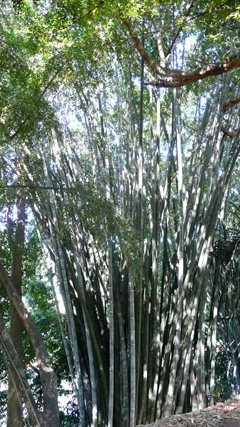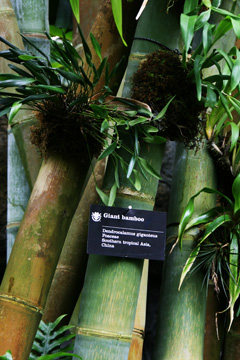 |
|
https://edibleplants.org/ |
 |
| https://edibleplants.org/ |
Translate this page:
Summary
Also known as Dragon Bamboo, Giant Bamboo or Dendrocalamus giganteus is one of the largest, dense-clumping bamboo species that is native to Southeast Asia. It reaches up to 40 m in height. It is greyish-green in colour and it grows in clumps. The culms are straight and thick-walled with a smooth surface. Young shoots are blackish purple in colour and are edible when cooked. Large culm sheaths are used to make hats and for many other purposes. Strips of the canes are used for weaving mats and baskets.
Physical Characteristics

 Dendrocalamus giganteus is an evergreen Bamboo growing to 30 m (98ft) by 15 m (49ft) at a fast rate.
Dendrocalamus giganteus is an evergreen Bamboo growing to 30 m (98ft) by 15 m (49ft) at a fast rate.
See above for USDA hardiness. It is hardy to UK zone 9. The flowers are pollinated by Wind.
Suitable for: light (sandy), medium (loamy) and heavy (clay) soils and prefers well-drained soil. Suitable pH: mildly acid, neutral and basic (mildly alkaline) soils. It can grow in semi-shade (light woodland) or no shade. It prefers moist soil.
UK Hardiness Map
US Hardiness Map
Synonyms
Bambusa gigantea Wall. ex Munro Sinocalamus giganteus (Munro) Keng f.
Plant Habitats
Edible Uses
Edible Parts: Shoots
Edible Uses:
The young shoots are edible[ 272 ]. Creamy and tender when cooked, though they are not widely consumed[ 303 ]. They have a fair canning quality[ 303 ].
References More on Edible Uses
Medicinal Uses
Plants For A Future can not take any responsibility for any adverse effects from the use of plants. Always seek advice from a professional before using a plant medicinally.
Aphrodisiac Tonic
The siliceous secretion of the culm is considered aphrodisiac and tonic[ 272 ].
References More on Medicinal Uses
The Bookshop: Edible Plant Books
Our Latest books on Perennial Plants For Food Forests and Permaculture Gardens in paperback or digital formats.

Edible Tropical Plants
Food Forest Plants for Hotter Conditions: 250+ Plants For Tropical Food Forests & Permaculture Gardens.
More

Edible Temperate Plants
Plants for Your Food Forest: 500 Plants for Temperate Food Forests & Permaculture Gardens.
More

More Books
PFAF have eight books available in paperback and digital formats. Browse the shop for more information.
Shop Now
Other Uses
Basketry Biomass Fibre Fodder Paper Pipes Soil stabilization Wood
Agroforestry Uses: Can be planted to protect the soil against erosion[ 303 ]. Other Uses: The large culm sheaths are used to make hats[ 303 ]. Strips of the canes are used for weaving mats and baskets[ 272 ]. The large culms are used for many purposes, including construction, scaffolding and rural housing, water pipes, buckets, boat masts, matting, woven wares and paper production[ 272 , 303 ]. The thick-walled culms are especially good for the production of bamboo boards, which are ideal material for room decoration and other practical interior applications such as walls, ceilings, floors, doors, shelves, etc[ 303 ].
Special Uses
Carbon Farming Food Forest
References More on Other Uses
Cultivation details
Fodder: Bank Industrial Crop: Biomass Management: Managed Multistem Minor Global Crop Other Systems: Multistrata Other Systems: Strip intercrop
A plant of the humid tropics and subtropics, where it is found at elevations up to 1,000 metres. It grows best in areas where annual daytime temperatures are within the range 20 - 27°c, but can tolerate 15 - 34°c[ 418 ]. It prefers a mean annual rainfall in the range 1,800 - 3,600mm, but tolerates 1,200 - 4,500mm[ 418 ]. Succeeds in full sun or in light shade[ 418 ]. Prefers a rich, alluvial soil[ 303 ]. Succeeds in most soils of at lest moderate fertility[ 418 ]. Prefers a pH in the range 5.5 - 6.5, tolerating 4.5 - 7.5[ 418 ]. Offsets consisting of young shoots with small portions of attached rhizome produce small culms in the first year[ 310 ]. Subsequent culms increase in size each consecutive year until, after 7 years, they have attained a girth of about 25 cm and a height of about 12 metres[ 310 ]. They are then harvested. However, culms only attain full size ultimately at an age of 15 - 16 years[ 310 ]. Bamboos have an interesting method of growth. Each plant produces a number of new stems annually - these stems grow to their maximum height in their first year of growth, subsequent growth in the stem being limited to the production of new side branches and leaves. In the case of some mature tropical species the new stem could be as much as 30 metres tall, with daily increases in height of 30cm or more during their peak growth time. This makes them some of the fastest-growing species in the world[ K ]. At first, the growth of an individual young shoot is very slow, quickening gradually during a period of 4 - 6 weeks until the culm is about 4 metres tall. Then maximum growth is attained and maintained for several weeks (e.g. On average, 32 cm per day), after which growth gradually decreases until it stops when full height is attained at the age of 3.5 months[ 310 ]. Rapid growth seems to be induced by high relative humidity, irrespective of light and temperature, causing a high turgescence in the culm[ 310 ]. Competition between culms in a clump may cause 'abortive shoots', affecting about 50% of all new shoots. Young abortion-prone shoots usually grow within 20 cm from a culm, attaining about 13 cm height before dying. Such young shoots are suitable for vegetable use[ 303 ] Bamboos in general are usually monocarpic, living for many years before flowering, then flowering and seeding profusely for a period of 1 - 3 years before usually dying. This species is reputed to have a cycle of around 40 years between major flowerings[ 361 ].
Carbon Farming
-
Fodder: Bank
Fodder banks are plantings of high-quality fodder species. Their goal is to maintain healthy productive animals. They can be utilized all year, but are designed to bridge the forage scarcity of annual dry seasons. Fodder bank plants are usually trees or shrubs, and often legumes. The relatively deep roots of these woody perennials allow them to reach soil nutrients and moisture not available to grasses and herbaceous plants.
-
Industrial Crop: Biomass
Three broad categories: bamboos, resprouting woody plants, and giant grasses. uses include: protein, materials (paper, building materials, fibers, biochar etc.), chemicals (biobased chemicals), energy - biofuels
-
Management: Managed Multistem
Regularly removing some multiple stems. A non-A non-destructive management systems maintaining the soil organic carbon.
-
Minor Global Crop
These crops are already grown or traded around the world, but on a smaller scale than the global perennial staple and industrial crops, The annual value of a minor global crop is under $1 billion US. Examples include shea, carob, Brazil nuts and fibers such as ramie and sisal.
-
Other Systems: Multistrata
Multistrata agroforests feature multiple layers of trees often with herbaceous perennials, annual crops, and livestock.
-
Other Systems: Strip intercrop
Tree crops grown in rows with alternating annual crops.
References Carbon Farming Information and Carbon Sequestration Information
Temperature Converter
Type a value in the Celsius field to convert the value to Fahrenheit:
Fahrenheit:
The PFAF Bookshop
Plants For A Future have a number of books available in paperback and digital form. Book titles include Edible Plants, Edible Perennials, Edible Trees,Edible Shrubs, Woodland Gardening, and Temperate Food Forest Plants. Our new book is Food Forest Plants For Hotter Conditions (Tropical and Sub-Tropical).
Shop Now
Plant Propagation
Seed - seldom available because the plant only flowers at intervals of many years. When it is available, sow the seed in containers and only just cover. Germination usually takes place readily. Prick out into individual pots as soon as the plants are large enough to handle. Plant out into permanent positions when 20cm tall. Plants may remain in their low-growing juvenile state for several years - cutting the culms to the ground level can stimulate taller adult growth[ 200 ]. Normally propagated by clump division[ 303 ]. Propagation by culm and branch cuttings is possible, although difficult[ 303 ]. Artificial ifiduction of roots before taking the cuttings is possible and reasonably successful[ 303 ].
Other Names
If available other names are mentioned here
Bhalu bans, Buloh semilang, Kyo-Chiku, Russei prei, Vai-mau, Wabo, Worra, dhungre bans, giant bamboo
Native Range
TEMPERATE ASIA: Yunnan Sheng,China. TROPICAL ASIA: Myanmar, Thailand (northwest),
Weed Potential
Right plant wrong place. We are currently updating this section.
Please note that a plant may be invasive in one area but may not in your area so it's worth checking.
Conservation Status
IUCN Red List of Threatened Plants Status : Status: Least Concern

Growth: S = slow M = medium F = fast. Soil: L = light (sandy) M = medium H = heavy (clay). pH: A = acid N = neutral B = basic (alkaline). Shade: F = full shade S = semi-shade N = no shade. Moisture: D = dry M = Moist We = wet Wa = water.
Now available:
Food Forest Plants for Mediterranean Conditions
350+ Perennial Plants For Mediterranean and Drier Food Forests and Permaculture Gardens.
[Paperback and eBook]
This is the third in Plants For A Future's series of plant guides for food forests tailored to
specific climate zones. Following volumes on temperate and tropical ecosystems, this book focuses
on species suited to Mediterranean conditions—regions with hot, dry summers and cool, wet winters,
often facing the added challenge of climate change.
Read More
Expert comment
Author
Munro.
Botanical References
Links / References
For a list of references used on this page please go here
A special thanks to Ken Fern for some of the information used on this page.
Readers comment
| Add a comment |
|
If you have important information about this plant that may help other users please add a comment or link below. Only comments or links that are felt to be directly relevant to a plant will be included. If you think a comment/link or information contained on this page is inaccurate or misleading we would welcome your feedback at [email protected]. If you have questions about a plant please use the Forum on this website as we do not have the resources to answer questions ourselves.
* Please note: the comments by website users are not necessarily those held by PFAF and may give misleading or inaccurate information.
To leave a comment please Register or login here All comments need to be approved so will not appear immediately.
|
Subject : Dendrocalamus giganteus
|
|
|
|